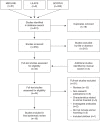Animal Hoarding: a systematic review
- PMID: 37243784
- PMCID: PMC10668307
- DOI: 10.47626/1516-4446-2022-3003
Animal Hoarding: a systematic review
Abstract
Objective: Animal hoarding is a special manifestation of Hoarding Disorder, characterized by the accumulation of animals and failure to provide them with minimal care. The main objective of this systematic review is to evaluate the characteristics of animal hoarding with a focus on the profile of affected individuals and accumulation behavior features.
Methods: A systematic search of the literature using the electronic databases MEDLINE, SCOPUS and LILACS was conducted until October 2022. We included case series (n ≥ 10) and cross-sectional studies assessing animal hoarding.
Results: 374 studies were initially retrieved. Most studies were classified as poor quality and significant risk of bias. 538 individuals with animal hoarding were evaluated. These individuals were predominantly middle-aged, unmarried females who lived alone in urban areas. Most residences presented unsanitary conditions. Recidivism rates varied from 13-41%. Cats and dogs were the main hoarded species, mostly acquired through unplanned breeding and found with lack of hygiene; diseases; injuries; and behavioral problems. Animal carcasses were found in up to 60% of the properties.
Conclusion: Animal hoarding is a complex condition that requires urgent attention. More research is necessary to develop effective strategies that can save community resources, improve animal and human welfare, and prevent recidivism.
Keywords: Animal hoarding; compulsive behavior; hoarding; hoarding disorder.
Conflict of interest statement
The authors report no conflicts of interest.
Figures
References
-
- Worth D, Beck AM. Multiple ownership of animals in New York City. Trans Stud Coll Physicians Philla. 1981;3:280. - PubMed
-
- Cassiday KL, Franklin R. Anxiety and Depression Association of America [Internet]. Animal hoarding. 2016 https://adaa.org/understanding-anxiety/obsessive-compulsive-disorder-ocd...
-
- Fontenelle LF, Grant JE. Hoarding disorder: a new diagnostic category in ICD-11? Rev Bras Psiquiatr. 2014;36:S28–39. - PubMed
-
- American Psychiatric Association . Diagnostic and Statistical Manual of Mental Disorders, Fifth Edition (DSM-5) Arlington: American Psychiatric Publishing; 2013.
-
- Berry C, Patronek G, Lockwood R. Long term outcomes in animal hoarding cases. Animal Law. 2005;11:167–94.
LinkOut - more resources
Full Text Sources
Miscellaneous

